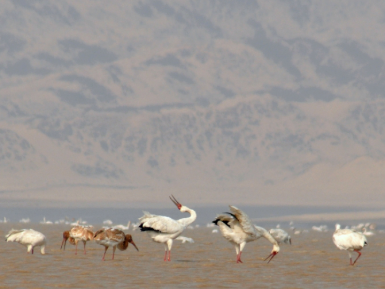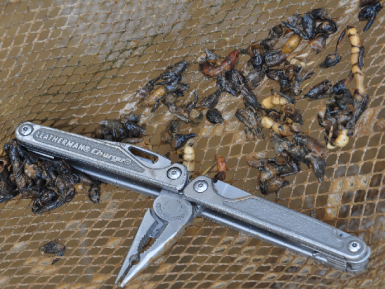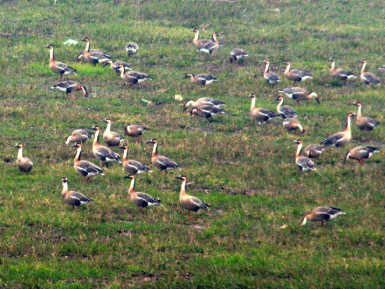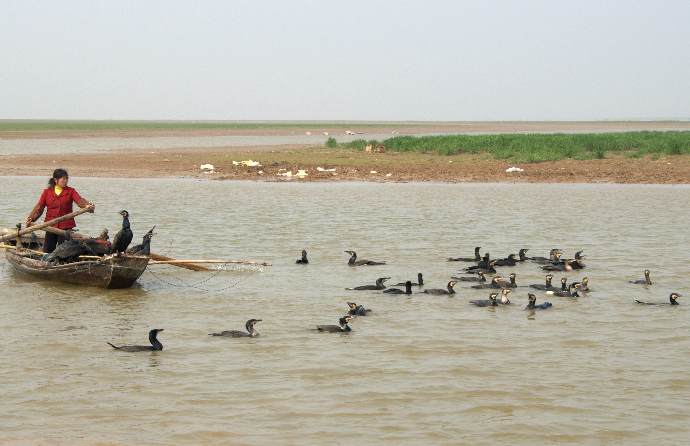Posted 08/9/11
James Burnham is conducting research to understand how endangered waterbird species depend on the shallow-water wetlands of China's Poyang Lake during the winter months. Typically, the birds specialize on one kind of water plant, Vallisneria, for their wintering needs. Following a flood in the summer of 2010, however, James observed cranes, swans and geese foraging in unusual places and exhibiting new kinds of behaviors. Now he's investigating what caused these changes.

The goal of migration is food. Many animals travel vast distances to ensure they get enough energy to complete their life cycles and produce offspring. Typically, these migrations follow established routes and patterns that reflect local food abundance along the way. What happens when an animal’s food source disappears during a migration? PhD student James Burnham thinks he witnessed a response to this phenomenon in migratory waterbird species that spend each winter at China’s Poyang Lake.Every year, hundreds of thousands of migratory waterbirds travel to Poyang to spend the winter months foraging and building up fat reserves for the return migration north in the spring. Poyang Lake is a dynamic wetland system with dramatically fluctuating water levels: high in the summer and low in the winter. When water levels recede in the fall, it uncovers seasonal meadows, mudflats and shallow, pothole lakes, creating a wide range of habitat for hundreds of migratory waterbird species. Typically, Siberian Cranes, Tundra Swans and Swan Geese depend on the shallow lakes at Poyang where they usually forage for below-ground tubers and rhizomes of the water plant Vallisneria. During his most

recent, four-month field season over the winter of 2010-2011, however, Burnham observed all three of these species foraging in areas outside of the pothole lakes. He observed swans foraging on sedges and Siberian Cranes foraging in the forb-rich transition zone between the sedges and higher, drier areas. Additionally, he observed Siberian Cranes exhibiting unusually aggressive behaviors towards co-foraging White-naped and Eurasian Cranes. In multiple instances, Siberian Cranes followed individuals of other species to food sources and then chase away the other bird to forage where they had been.Burnham believes that a summer flood event in 2010 is the main culprit behind these new habitat use patterns and behaviors. The 2010 flood was the worst to hit Poyang since devastating floods ravaged the area in 1998, killing thousands and causing billions in damage. Unlike the post-flood behavior Burnham observed in 2010-2011, however, observers in the winter of 1998-1999 recorded the water birds feeding in their typical foraging habitats in and around the pothole lakes. Burnham has a two-part hypothesis to explain why the birds behaved so differently following the 2010 flood: 1) the flood occurred early in the Vallisneria growing season, before the plant could become widely established across the lake basin, and 2) new aquaculture practices, such as crab farming, removed Vallisneria that had been present in un-flooded areas in previous years. Burnham is working with multiple partners from China, the United States and Europe to help him put together the pieces of this puzzle.

According to Burnham, shifts in foraging habitat exhibited by wintering waterbirds at Poyang are important indicators of the overall health of Poyang’s ecosystem. A large-scale loss of Vallisneria in the lake will not only be detrimental to waterbirds, but also several species of fish that depend on Vallisneria for habitat. Hundreds of communities across the lake basin depend on those fish for food and income throughout the year. He hopes that better understanding changes in waterbird foraging behavior can inform the management of protected areas, help direct development initiatives in the lake basin, and shape future conservation efforts for these species of concern.Burnham feels that the shift from one food resource to another by the cranes, swans and geese will provide important insight into how the birds will respond to future extreme events. Poyang continues to be a dynamic wetland: this spring, the lake experienced an abnormal drought and water levels were at some of the lowest levels ever recorded. Whether this latest extreme event will affect the migrants remains to be seen, but Burnham looks forward to investigating how this latest puzzle piece changes the picture at Poyang. style=”text-align:”>

“
Story by Radeloff, Volker
